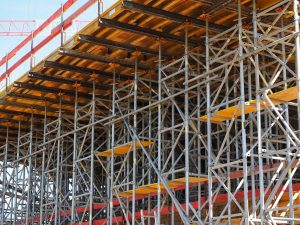Print a Sign-In Sheet | Spanish Version
Most of the construction projects in the United States have some sort of scaffolding on the jobsite at some point during the various phases of construction. There are three main types of scaffolds: suspension, supported, and aerial lifts.
The federal Bureau of Labor Statistics indicates that scaffold accidents result in 4,500 injuries and over 60 deaths each year. Common hazards of working off scaffolding include falls, falling objects, electrical hazards, scaffold collapse, scaffold access, bad planking, and weather conditions.
- Always use scaffolding according to the manufacturer’s instructions.
- If a worker is working 10 feet or higher off scaffolding, then the worker must be protected by guardrails or a personal fall arrest system (PFAS).
- Guardrails must be installed along all sides and ends to protect from fall hazards. Top rails must be between 38 to 45 inches high, midrails should be halfway between the platform and top rail, and toe boards must be at least 3 1/2″ high.
- PFAS must include an anchorage point, lifeline, and full-body harness. A PFAS can be used instead of guardrails on some scaffolds. A PFAS and guardrails must be used on all suspension scaffolds. Scaffold erectors and dismantlers use a PFAS when feasible.
- Wear a hard hat, utilize the toeboard, and barricade the area beneath a scaffold to help with falling object hazards.
- Barricade an area around a scaffold to keep equipment and vehicles from running into and striking the scaffold.
- Working near overhead powerlines is a serious electrical hazard when working off the scaffolding. Stay back at least 10 feet or check the clearance distances in the standard.
- Scaffolding must be on good support with mudsills and base plates. Be sure to use appropriate scaffold construction.
- The height of the scaffold should not be four times its minimum base dimensions.
- Erect scaffolding on a stable and level ground.
- Component pieces must match and be of the same type.
- Always lock wheels or restrain the scaffolding with ties, guys, and braces to keep from tipping or accidental movement.
- Platforms should be fully planked and be able to support four times the maximum load. Use scaffold-grade wood and do not paint wood platforms.
- Provide proper access when getting on and off the scaffolding. A ladder, stair tower, ramp, walkway, etc., must be put in place when scaffold platforms are more than two feet above or below a point of access. (You may use building stairs and come out of the window if you can step out onto the scaffold.)
- Do not climb cross braces for scaffold access.
- Do not use in bad weather conditions, such as snow, ice-covered surfaces, during storms, and high winds.
The Competent Person must be able to:
- Identify and correct hazards.
- Determine if it is safe to work on scaffolding.
- Select and train qualified workers to conduct work on scaffolding.
- Inspect scaffolds for visible defects each day or before each shift.
- Make repairs (if needed) or red tag scaffold if it is unsafe and should not be used.
- Green tag a scaffold post-inspection to show that it is ready for use.
- Determine the feasibility of fall protection.
- Train employees on scaffold hazards and procedures to control the hazards.
KEMI does not assume liability for the content of information contained herein. Safety and health remain your responsibility. This information is to be used for informational purposes only and not intended to be exhaustive or a substitute for proper training, supervision, or manufacturers’ instructions/recommendations. KEMI, by publication of this information, does not assume liability for damage or injury arising from reliance upon it. Compliance with this information is not a guarantee or warranty that you will be in conformity with any laws or regulations nor does it ensure the absolute safety of any person, place, or object, including, but not limited to, you, your occupation, employees, customers, or place of business.

